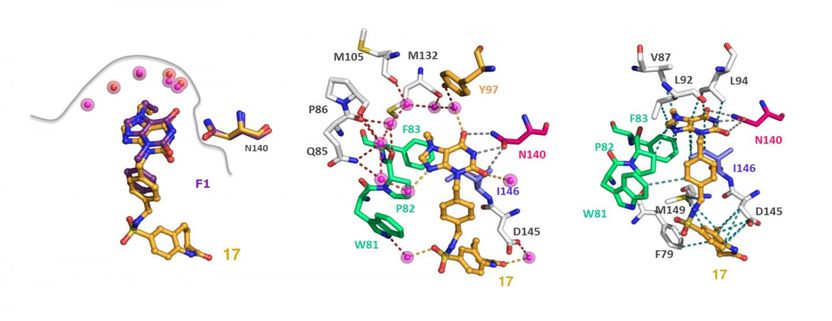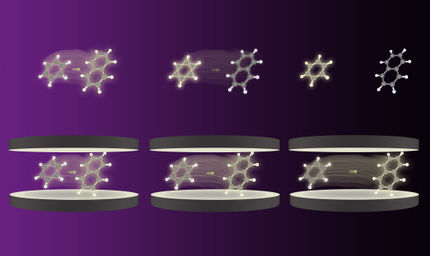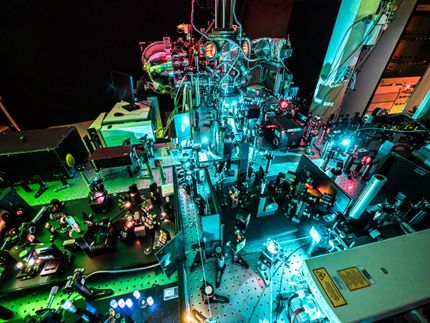An effective approach to optimizing medicinal molecules
The search for new medicinal molecules with predetermined properties is a rather complex, expensive and time-consuming process, especially in oncology. Modern science allows us to accelerate this search through the use of computer technology and the introduction of automated processes. In the development of biologically active molecules, there are two basic concepts - a medicinal molecule and a therapeutic target.

Comparison of the binding mode of F1 and compound 17.
Lobachevsky University
The molecule binds to the target, most often a protein, thereby affecting certain cellular functions. If the therapeutic target is known, then the first step in the design of a new drug is to search for small molecules that can interact with the target. The molecules are selected from huge virtual chemical libraries, which include millions of compounds.
During the last decade, the process of selecting potential medicinal molecules has been greatly simplified by the introduction of robotic high-throughput screening, which allows testing thousands of compounds in a short time.
Compound prototypes that have been screened during high-throughput screening, although capable of interacting with the protein of interest, are still far from the final drug and cannot be immediately used in pre-clinical and clinical trials.
To begin preclinical studies, biologically active molecules must meet a number of criteria, such as high activity with respect to the target protein, the absence of effect on other targets, and good pharmacokinetics, i.e. the ability of the molecule to enter the body, to be distributed there, to be cleared from the body and to have no toxic effect on it. In search for a molecule that meets all the necessary criteria, prototype compounds undergo an optimization phase, which is also quite costly and time consuming.
According to Alexei Fedorov, Head of the Organic Chemistry Department at the Lobachevsky University, the international research group has developed a strategy to significantly accelerate and automate the process of prototype molecule optimization. Such molecules then become candidates for subsequent preclinical trials.
"In this approach, we have combined the design of a chemical library focused at the therapeutic target of interest, virtual (computer) screening of the library obtained, as well as automated synthesis and study of the biological activity of the resulting molecules in vitro," notes Alexei Fedorov
At the first stage of this approach, the interaction model of the chosen prototype molecule with the target is determined using X-ray diffraction analysis. Then, based on the data obtained, a new virtual chemical library is designed. In this case, the prototype molecule is the main building block, to which new components that correspond to the structure of the target protein are added.
To integrate building blocks into new molecules, carefully selected chemical reactions are used that meet the requirements of medical chemistry. Selection of chemical reactions ensures that the compounds of a new chemical library can be easily obtained by organic chemistry methods in one or two stages with high yields and without by-products.
The next stage involves computer screening of the obtained virtual library in order to select the molecules capable of optimal interaction with the target and possessing the necessary properties, such as solubility, bioavailability, toxicity, etc. All this significantly increases the chances of finding a potential candidate for the role of a medicinal molecule.
Finally, the compounds selected in the course of computer screening are synthesized, and their biological properties are tested in vitro. Both these processes can now be fully automated and can be performed by robots, which significantly reduces the development time of new drug compounds.
The effectiveness of the proposed strategy was demonstrated by optimizing antitumor substances - inhibitors of bromodomain-containing proteins. This class of proteins is involved in the regulation of a number of genes that play a key role in the development of cancer.
"Earlier, our group identified a prototype molecule that can effectively interact with this therapeutic target. Prototype optimization using the described technique made it possible to obtain several candidate molecules that bind to the target 60 times better. They also showed improved selectivity, water solubility, and efficiency in cell tests. Currently, the molecules are being prepared for preclinical trials to treat various types of tumors," concludes Professor Fedorov.
At present, the targeted design of new medicinal molecules has become an important part of pharmacology. The transition from a trial and error method to a truly rational design of medicines, achieved through the introduction of computer and robotic approaches into medical chemistry, opens the way to a more efficient and faster production of new medicinal molecules with the desired physico-chemical properties and biological action.
Original publication
Laurent Hoffer, Yuliia V. Voitovich, Brigitt Raux, Kendall Carrasco, Christophe Muller, Aleksey Y. Fedorov, Carine Derviaux, Agnès Amouric, Stéphane Betzi, Dragos Horvath, Alexandre Varnek, Yves Collette, Sébastien Combes, Philippe Roche, and Xavier Morelli; "Integrated Strategy for Lead Optimization Based on Fragment Growing: The Diversity-Oriented-Target-Focused-Synthesis Approach"; J Med Chem; 2018
Other news from the department science
Most read news
More news from our other portals
See the theme worlds for related content
Topic world Synthesis
Chemical synthesis is at the heart of modern chemistry and enables the targeted production of molecules with specific properties. By combining starting materials in defined reaction conditions, chemists can create a wide range of compounds, from simple molecules to complex active ingredients.

Topic world Synthesis
Chemical synthesis is at the heart of modern chemistry and enables the targeted production of molecules with specific properties. By combining starting materials in defined reaction conditions, chemists can create a wide range of compounds, from simple molecules to complex active ingredients.






























































